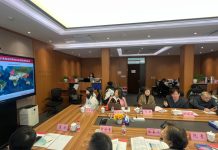BEIJING: Traveling abroad is on the to-do list of many Chinese in 2023. Searches for international flights on Ctrip, one of China’s largest online travel agencies, saw a sevenfold increase in the 15 minutes after new policies were issued on December 26, 2022. Authorities have announced the relaxation of COVID-19 control measures, canceled inbound quarantine for international arrivals, and resumed outbound travel starting from January 8.
As the pathogenicity of Omicron has weakened compared with the original strain of the coronavirus and its other variants, China is preparing to boost all-round recovery in 2023. The annual Central Economic Work Conference took place in Beijing on December 15-16, 2022, outlining priorities for the government’s economic work in 2023, chief among which is bolstering economic stability.
The tone-setting conference came after the government issued 10 new measures to optimize COVID-19 response in early December, including allowing home quarantine for mild and asymptomatic cases and reducing the need for mandatory nucleic acid testing. Malls, restaurants and other brick-and-mortar stores in many regions have reopened as digital health codes of test results are no longer required for entry, leading to an increase in customers.
The optimized COVID-19 response will have a “J-curve effect” on the Chinese economy in 2023, meaning it may cause a temporary downturn but will bring long-term benefits, Han Wenxiu, Executive Deputy Director of the Office of the Central Committee for Financial and Economic Affairs, told a think tank forum in Beijing on December 17.
The Central Economic Work Conference said the government will continue to implement a proactive fiscal policy and prudent monetary policy in 2023, with the aim to ensure sound growth of major indicators, particularly domestic demand, employment and foreign trade.
Over the past three years, China managed to keep rates of severe illness and death from COVID-19 among the lowest in the world. It registered an average annual economic growth of 4.5 percent in 2020-22, higher than the global average.
“As outlined at the conference, the government will launch more proactive policies, and COVID-19 impacts will be minimized. China’s economic growth is expected to resume its pre-pandemic levels in the second quarter of 2023 as it enters the post-pandemic period,” Wen Bin, chief analyst at China Minsheng Bank, told Beijing Review.Late-night lights, queues of diners and mouth-watering smells mark the recovery of Guijie, one of the most famous food streets in Beijing. Huda, a popular chain of crayfish restaurants on the street, is one of the food and beverage establishments that have felt the positive impact of the COVID-19 response optimization. Huda’s business has picked up since mid-December. For people favoring hot flavors, spicy crayfish is a popular nighttime meal.
“Since customers were not allowed to dine in starting from late November last year due to tightened COVID-19 restrictions, Huda closed two of its restaurants in the period.
To help cope with the challenge, the three remaining restaurants all continued providing takeaway services.
–The Daily Mail-Beijing review news exchange item






